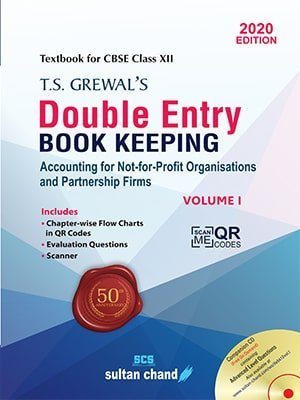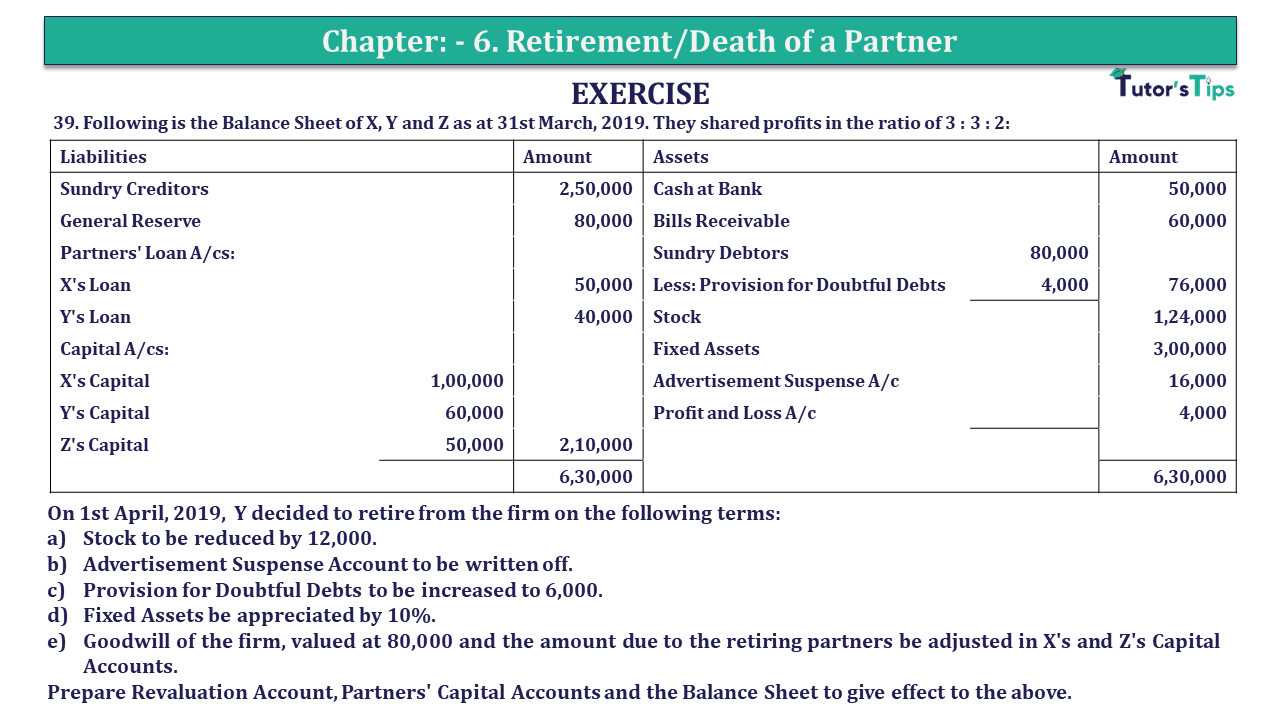Question 39 Chapter 6 of +2-A
39. Following is the Balance Sheet of X, Y, and Z as of 31st March 2019. They shared profits in the ratio of 3 : 3 : 2:
| Liabilities | Amount | Assets | Amount | ||
| Sundry Creditors | 2,50,000 | Cash at Bank | 50,000 | ||
| General Reserve | 80,000 | Bills Receivable | 60,000 | ||
| Partners’ Loan A/cs: | Sundry Debtors | 80,000 | |||
| X’s Loan | 50,000 | Less: Provision for Doubtful Debts | 4,000 | 76,000 | |
| Y’s Loan | 40,000 | Stock | 1,24,000 | ||
| Capital A/cs: | Fixed Assets | 3,00,000 | |||
| X’s Capital | 1,00,000 | Advertisement Suspense A/c | 16,000 | ||
| Y’s Capital | 60,000 | Profit and Loss A/c | 4,000 | ||
| Z’s Capital | 50,000 | 2,10,000 | |||
| 6,30,000 | 6,30,000 | ||||
On 1st April 2019, Y decided to retire from the firm on the following terms:
- Stock to be reduced by 12,000.
- Advertisement Suspense Account to be written off.
- Provision for Doubtful Debts to be increased to 6,000.
- Fixed Assets be appreciated by 10%.
- Goodwill of the firm, valued at 80,000, and the amount due to the retiring partners be adjusted in X’s and Z’s Capital Accounts.
Prepare Revaluation Account, Partners’ Capital Accounts, and the Balance Sheet to give effect to the above.
The solution of Question 39 Chapter 6 of +2-A: –
| Revaluation Account |
|||||
| Particular |
Amount | Particular | Amount | ||
| To Stock A/c | 12000 | By Fixed Assets A/c | 30,000 | ||
| To Prov. for Doubtful Debts | 2000 | (3,00,000 × 10%) | |||
| (6,000 – 4,000) | |||||
| To Profit transferred to | |||||
| X’s Capital A/c | 6000 | ||||
| Y’s Capital A/c | 6000 | ||||
| Z’s Capital A/c | 4000 | 16000 | |||
| 30000 | 30000 | ||||
| Partners’ Capital Account |
|||||||
| Part. | X | Y | Z |
Part. |
X | Y | Z |
| To Profit and Loss A/c | 1500 | 1500 | 1000 | By Balance B/d | 1,00,000 | 60,000 | 50,000 |
| To Advertise Suspense A/c | 6000 | 6000 | 4000 | By General Reserve A/c | 30,000 | 30,000 | 20000 |
| To Y’s Capital A/c | 18000 | – | 12000 | By Revaluation A/c | 6000 | 6000 | 4000 |
| To Y’s Loan A/c | 1,58,500 | By X’s Capital A/c | – | 18000 | – | ||
| To Balance c/d | 1,10,500 | – |
57,000 |
By Z’s Capital A/c | – | 12000 | – |
| 1,36,000 | 1,26,000 | 74,000 | 1,36,000 | 1,26,000 | 74,000 | ||
Note: – General Reserve A/c, Profit and Loss A/c, and Advertise Suspense A/c all are distributed in the old ratio.
| Balance Sheet |
|||||
| Liabilities |
Amount | Assets | Amount | ||
| Sundry Creditors | 2,50,000 | Cash at Bank | 50000 | ||
| X’s Loan | 50,000 | Bills Receivable | 60000 | ||
| Y’s Loan | 1,58,500 | Debtors | 80,000 | ||
| Less: Prov. For D/D | 6,000 | 74,000 | |||
| Stock | 1,12,000 | ||||
| Capital A/cs | (1,24,000 – 12,000) | ||||
| X’s Capital | 1,10,500 | Fixed Assets | 3,30,000 | ||
| Z’s Capital | 57,000 | 1,67,500 | (3,00,000 + 30,000) | ||
| 6,26,000 | 6,26,000 | ||||
| Y’s Loan Account |
|||||
| Liabilities |
Amount | Assets | Amount | ||
| By Balance b/d | 40000 | ||||
| Y’s Capital A/c | 1,18,500 | ||||
| To Balance c/d | 1,58,500 | ||||
| 1,58,500 | 1,58,500 | ||||
Working Note:-
Calculation of Gaining Ratio
Old Ratio of X, Y, and Z = 3:3:2
Y retires from the firm.
Gaining Ratio of X and Z = 3:2 (Given)
Adjustment of Goodwill
Goodwill of the firm = Rs 80,000
| Y’s Share of Goodwill | = | Firm’s Goodwill | X | B’s share |
| = | 80,000 | X | 3 | |
| 8 | ||||
| = | Rs 30,000 |
Advertisement-X
| X’s Share of Goodwill | = | Y’s Goodwill | X | Gaining share of X |
| = | 30,000 | X | 3 | |
| 5 | ||||
| = | Rs 18,000 |
| Z’s Share of Goodwill | = | Y’s Goodwill | X | Gaining share of Z |
| = | 30,000 | X | 2 | |
| 5 | ||||
| = | Rs 12,000 |
T.S. Grewal’s Double Entry Book Keeping +2 (Vol. I: Accounting for Not-for-Profit Organizations and Partnership Firms)
- Chapter No. 1 – Financial Statement of Not-For-Profit Organisations
- Chapter No. 2 – Accounting for Partnership Firms – Fundamentals
- Chapter No. 3 – Goodwill: Nature and Valuation
- Chapter No. 4 – Change in Profit-Sharing Ratio Among the Existing Partners
- Chapter No. 5 – Admission of a Partner
- Chapter No. 6 – Retirement/Death of a Partner
- Chapter No. 7 – Dissolution of a Partnership Firm
T.S. Grewal’s Double Entry Book Keeping (Vol. II: Accounting for Companies)
- Chapter No. 8 – Company Accounts – Accounting for Share Capital
- Chapter No. 9 – Company Accounts – Issue of Debentures
- Chapter No. 10 – Redemption of Debentures
T.S. Grewal’s Double Entry Book Keeping (Vol. II: Accounting for Companies)
- Chapter No. 1 – Financial Statements of a Company
- Chapter No. 2 – Financial Statement Analysis
- Chapter No. 3 – Tools of Financial Statement Analysis – Comparative Statements and Common- Size Statements
- Chapter No. 4 – Accounting Ratios
- Chapter No. 5 – Cash Flow Statement
Check out T.S. Grewal +2 Book 2020@ Official Website of Sultan Chand Publication








Leave a Reply